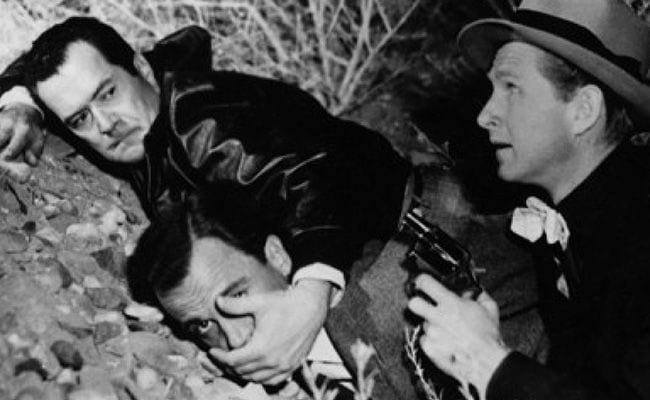
From the dawn of the ‘50s comes this overlooked noir; now restored to glittering clarity on Blu-ray.
The film opens with an ominous, emblematic pre-credits scene of a blind preacher haranguing a crowd from a platform on the street. As people rush by, the rumbling effect sounds like an invasion or earthquake. A much shorter version of this scene will be repeated at the climax, making this an early example where a film opens with a preview of events to come. This scene and its sound effects factor into the movie’s original release title, The Sound of Fury, which also refers to its being inspired by the same real-life events that drove Fritz Lang’s Fury (1936).
During the credits, Howard Tyler (Frank Lovejoy) hitches a ride with a trucker and explains how he’s failed to find a job and that he can’t leave the area because of his family. “They really drop a net over you, don’t they?” asks the trucker, who proceeds to blame women for tying men down. Tyler arrives at his house on a desolate lot surrounded by barbed wire, where his lovely pregnant wife (Kathleen Ryan, with a slight Irish lilt) tussles with their rude noisy boy in what feels like a cramped prison.
The kid will later dress as a cowboy with six-guns, inspired by a scene of ’50-era TV culture where everyone gathers at the house of the one neighbor with a television. This desire to acquire and consume, heightened by poverty’s desperation and disempowerment (specifically emasculation for the male provider), is all seen as part of “the net”. More subtly, so is the idealization of rugged American myths of solving problems by violence. Very few American films work against that myth, which is part of what makes the Coen Brothers’ output unique.
Tyler soon becomes effectively seduced by Jerry Slocum (Lloyd Bridges: excellent as always), a flashy, fast-talking sociopath, who lures him to his hotel room and parades around shirtless, encouraging Tyler to smell his cologne and feel his silk shirt before throwing money at him as if he were a prostitute. Seduced, albeit in a different way, Tyler goes along with this guy in a series of robberies that of course escalate. The film partially charts Tyler’s breakdown, especially in a nightclub sequence of all tilted angles where his public embarrassment is part of the sexy sozzled gaiety. Making the most of many fine close-ups, Katherine Locke arrives in the story as a lonely manicurist attracted to Tyler, who’s told her he’s not married.
A secondary plot involves a well-heeled, narcissistic newspaper columnist (Richard Carlson) writing inflammatory stories about the “crime wave”, leading to a resolution that’s impossible to anticipate because American movies just don’t end like this. If the movie implies that Tyler’s spoiled son could grow up to be Bridges’ character, it also implies the latter could be the vulgar flipside of Carlson’s.
Jo Pagano’s script, from his 1947 novel The Condemned as derived from a 1933 incident in San Jose, can’t resist a few awkward speeches from Voices of Reason, but what we see and what’s unspoken are the most powerful elements. Every scene is packed with more characters than are strictly necessary, who convey a jostling world of self-absorbed individuals which coalesces into the climactic mass. The thematic connections stretch backward to Fury and They Won’t Forget (1937), and forward to Ace in the Hole (1951) and In Cold Blood (1967) — a phrase which is actually spoken in the film — making this one of the most vivid and downbeat noirs of its decade.
For most of the film, there’s no music unless it’s written into the scene: only natural or expressionist sounds. Hugo Friedhofer provides a score, but it’s used sparingly. This approach, along with the clarity of Guy Roe’s photography until its nightmarish chiaroscuro culmination, and the middle-American clutter of Perry Ferguson’s production design, anchors the potential melodrama in reality. George Amy’s brilliant editing also deserves a shout-out.
Released through United Artists, the indie production was the first feature produced by Robert Stillman, who’d previously assisted Stanley Kramer on the hard-hitting, socially conscious Champion (1949) and Home of the Brave (1949). Stillman’s associate producer, Seton I. Miller, had worked on many classic gangster and prison pictures as well as Lang’s Ministry of Fear (1944). Director Cyril Endfield had the same year made The Underworld Story (1950) about the inflammatory power of the press. He would soon be blacklisted and relocate to England, where Zulu (1964) became his most famous film.
This movie was nominated for a BAFTA in England, but Americans in 1950 didn’t want to see this sour, grubby, dirt-eating vision of themselves as a whisper away from receiving, and committing, violence at any moment. Thus, Stillman tried a new ad campaign and changed the title from The Sound of Fury to the more sensational Try and Get Me in most markets, but public and critics remained apathetic. According to the American Film Institute’s website, New York’s state censors demanded the final reel be removed, which is revealing if true. They state: “No information has been found that Stillman appealed the ruling.”
But The New York Times clearly saw the whole picture, which Bosley Crowther reviewed at the Globe Theatre, because his write-up singles out the effective ending while finding the rest “conventional” and not “distinctive”. Under these questionable complaints, we find his assertion that the film is “doleful and negative”, and that “the main weakness” is that “we are asked to expend pity and resentment toward society in the cause of a common thief”. Apparently he’d have preferred the drama to stack its deck by centering on an innocent man, because there’s something in him that wishes to sympathize with the crowd. In this, he might indeed have been speaking for the common man.


![Call for Papers: All Things Reconsidered [MUSIC] May-August 2024](https://www.popmatters.com/wp-content/uploads/2024/04/all-things-reconsidered-call-music-may-2024-720x380.jpg)



